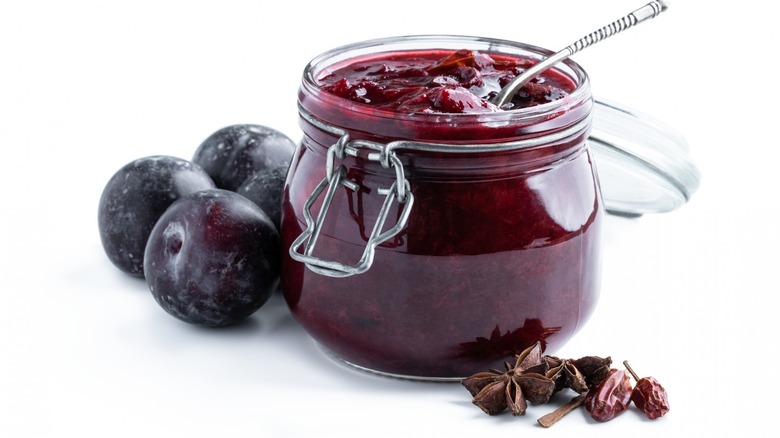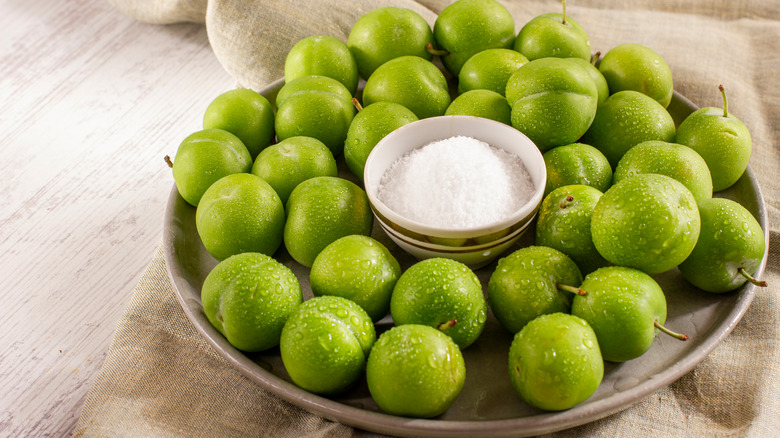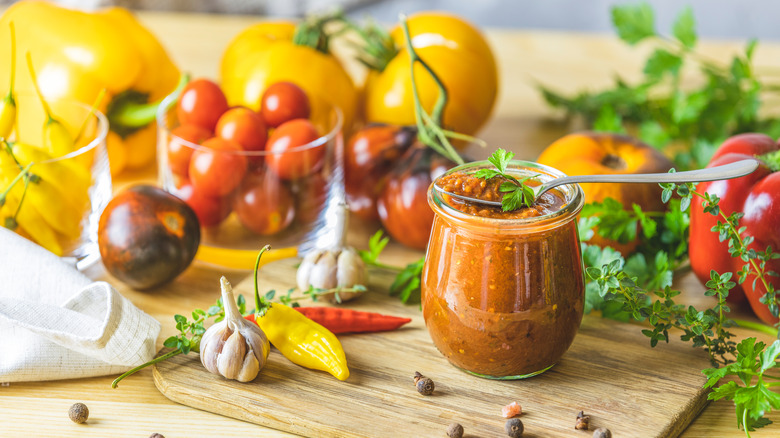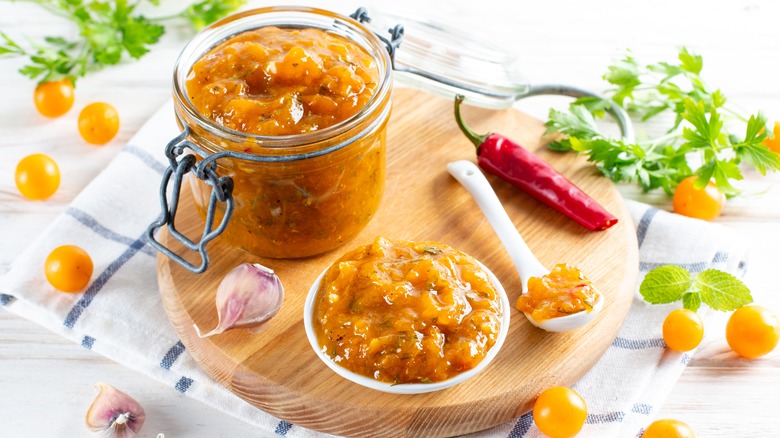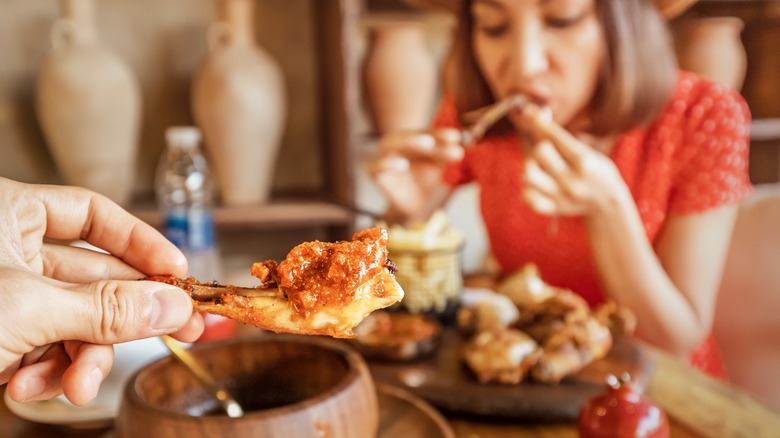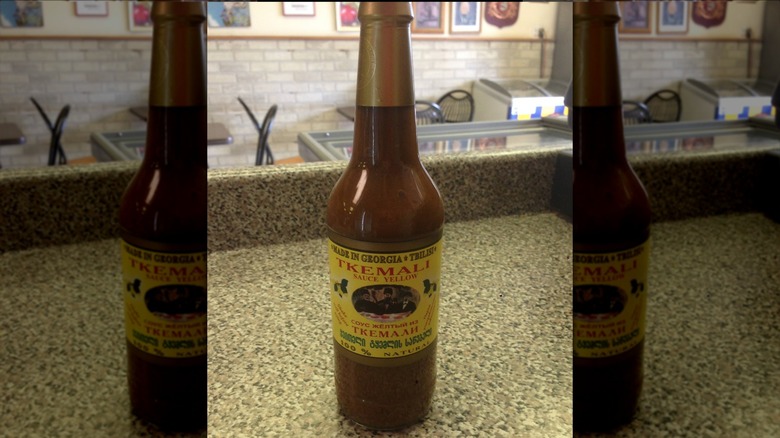Tkemali Receives Its Saucy Profile From Plums
We may receive a commission on purchases made from links.
Of all the different types of world cuisine available to us, more than a few get lost in the shuffle. One type of food that's not too widely known in the U.S. is that native to Georgia –- the Republic of, not the state that gave birth to Chick-fil-A and Waffle House. Georgia the country is known for its wine-making as well as certain dishes like the cheese-and-egg-stuffed bread boats called khachapuri, the garlicky meat and walnut stew known as kharcho, and the sausage-shaped candy called churchkhela that's made from walnuts and grape juice. Georgia even has its own signature condiment: tkemali, which is a type of plum sauce.
Tkemali, which sometimes goes by the nickname "Georgian ketchup," is used as a topping for just about anything (with the possible exception of ice cream). It gets its name from a particular type of plum, the variety known to us as cherry plums (Prunus cerasifera). While the condiment itself isn't limited to any one particular season, it's nevertheless associated with springtime since this is the season when plum trees begin to bear fruit.
Tkemali's historical and cultural background
Tkemali sauce might be seen as a natural extension of the Georgian preference for eating unripe tkemali plums with a sprinkling of salt as both plum and salty elements are among the sauce's main characteristics. While the roots of the sauce aren't easy to trace, it does seem to have been around for several centuries and may have been created out of the necessity for preserving spring and summer fruits throughout the long Georgian winters.
Tkemali, while it is pretty much only made in Georgia, isn't associated with any one part of the country, although it may be more prevalent in mountainous regions or areas where there's a preponderance of plum trees. The town of Tkibuli in western Georgia, however, has staked a claim to the sauce in more modern times. Tkibuli was once a center of coal mining but has since switched to tea growing. Every September, though, it transforms into Tkemali Central by hosting an annual plum-themed Tkemali Festival.
What goes into tkemali
While tkemali is made from the plums of the same name, its color and flavor may vary depending on what time of year the plums were picked. Tkemali that's been made fresh in the months of May and June may be green or yellow and very, very tart, while summertime tkemali may be made from riper, redder plums and its tanginess is toned down a bit.
Apart from the plums, tkemali recipes may vary with the maker, although nearly all of these will contain salt, cilantro, and mint. Some sauce makers may add dill or other herbs such as coriander, fenugreek, and thyme, while others opt for garlic or chile peppers to give the tkemali a bit more zing. Lemon juice or citric acid may also be added if the plums used are insufficiently sour.
Even though tkemali plums are, of course, the traditional ones used in their namesake sauce, the condiment can be made with other types of plums as well. In fact, there are even variant versions made with blackberries, cherries, grapes, or pomegranates, although these may not be considered true tkemalis but rather tkemali-adjacent fruit sauces.
How tkemali tastes
The primary flavor combination at play in a typical tkemali recipe is a combination of sour and salty. Fruity, as well, since plums are by definition a fruit. Depending on how ripe the plums may be, you might be able to detect a certain sweetness, as might also be the case with some of the other fruit-based tkemali variants described above. Unlike many of the fruit sauces we're familiar with, including Asian-style plum sauce, no sugar or other sweetener is added to tkemali (though it can be to counteract sourness). It is certainly intended to be a savory condiment instead of a sweet one such as tomato ketchup.
Depending on what other ingredients are used to make tkemali, it will be influenced by those flavors, as well. The cilantro might give it a slightly soapy taste, at least if you're someone whose genetic profile causes you to hate this herb, while the mint will lend it some mintiness, and using dill will tend to make it taste, well, dilly. Other types of herbs might make the tkemali slightly bitter, while the addition of garlic will cause it to be more pungent. Chile peppers, of course, will raise the heat level of the sauce.
How to use tkemali
Tkemali, as might be expected, makes a great sauce for most meats: Beef, chicken, fish, lamb, and pork are all complemented by its not-so-sweet fruitiness. By some accounts, tkemali is often used as a Georgian barbecue sauce, albeit one closer to the vinegary tang of the Carolinas than the sugary tomato-based barbecue sauce more common in Kansas City. Tkemali can also be added to cooked dishes like stews and soups or used as a burger topping a la ketchup (only much less cloying).
Another use for tkemali is as a dip for the fries that may be accompanying that burger. It goes well with all manner of other vegetables, too, and can even be used as a salad dressing, although if the salad in question is a lettuce-based one the sauce might need to be thinned out with some oil. Tkemali makes a great dip for dumplings, particularly the Georgian soup dumplings known as khinkali. It can also be used on eggs and, at its simplest, simply spread on slices of bread like a savory version of fruit preserves.
Where to buy tkemali
While many sources speak of tkemali as the type of thing "everybody" in Georgia makes at home, this may not necessarily be true, any more than it would be true to claim that all Americans make homemade macaroni and cheese rather than buying the prepared kind from a grocery store or restaurant. One piece of evidence supporting the fact that not every Georgian DIYS their own tkemali is the fact that commercially prepared sauces are available at supermarkets in the Republic Of Georgia and also at small corner markets. In the latter case, though, it may be packed rather informally in bottles that once held soda.
If you are not in Georgia (or you're in the one whose capital is Atlanta rather than Tbilisi), then you can always (let's say it in unison): "Order it from Amazon!" because of course, this one-stop shop for all the things carries a wide selection of tkemalis both green and red. Tkemali can also be purchased from other online vendors as well as brick-and-mortar vendors such as GeorgiaLand in Brooklyn. This condiment can also be found on the menu (or at least served on the side) at eateries such as Brooklyn's Georgia House, and Chicago Diplomat Cafe.
